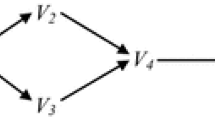Abstract
The faithfulness condition (FC) is a useful principle for inferring causal structure from statistical data. The usual motivation for the FC appeals to theorems showing that exceptions to it have probability zero, provided that some apparently reasonable assumptions obtain. However, some have objected that, the theorems notwithstanding, exceptions to the FC are probable in commonly occurring circumstances. I argue that exceptions to the FC are probable in the circumstances specified by this objection only given the presence of a condition that I label homogeneity, and furthermore that this condition typically does not obtain in the FC’s intended domain of application.
Similar content being viewed by others
References
Billingsley, P. (1995). Probability and measure (3rd edn.). New York, NY: Wiley.
Cartwright, N. (1999a). The dappled word: a study of the boundaries of science. Cambridge: Cambridge University Press.
Cartwright, N. (1999b). Causal diversity and the Markov condition. Synthese, 121, 3–27.
Chu, T., Glymour, C., Scheines, R., & Spirtes, P. (2003). A statistical problem for inference to regulatory structure from associations of gene expression measurement with microarrays. Bioinformatics, 19, 1147–1152.
Glymour, C. (1999). Rabbit hunting. Synthese, 121, 55–78.
Glymour, C., & Cooper, G. (Eds.) (1999). Computation, causation, and discovery. Menlo Park, CA: American Association for Artificial Intelligence.
Halmos, P. (1950). Measure theory. New York: D. Van Nostrand Company.
Hoover, K. (2001). Causality in macroeconomics. Cambridge, UK: Cambridge University Press.
Howson, C., & Urbach, P. (1993). Scientific reasoning: The Bayesian approach (2nd edn.). La Salle, IL: Open Court Press.
Liljegren, S., Ditta, G., Eshed, Y., Savidge, B., Bowman, J., & Yanofsky, M. (2000). Shatterproof MADS-box genes control seed dispersal in Arabidopsis. Nature, 404, 766–770.
Lindsey, J. K. (1996). Parametric statistical inference. Oxford: Clarendon Press.
Meek, C. (1995). Strong completeness and faithfulness in Bayesian networks. In P. Besnard (Ed.), Uncertainty in artificial intelligence: Proceedings of the 11th conference (pp. 411–418). San Francisco: Morgan Kaufman Publishers.
Neopolitan, R. (2004). Learning Bayesian networks. Upper Saddle River, NJ: Prentice Hall.
Pearl, J. (1998). TETRAD and SEM. Multivariate Behavioral Research, 33, 119–128.
Pearl, J. (2000). Causality: Models, reasoning, and inference. Cambridge: Cambridge University Press.
Pearson, H. (2002). Surviving a knockout blow. Nature, 415, 8–9.
Port, S. C. (1994). Theoretical probability for applications. New York: Wiley.
Robins, J. M., & Wasserman, L. (1999). On the impossibility of inferring causation from association without background knowledge. In: C. Glymour, & G. Cooper (Eds.), Computation, causation, and discovery (pp. 305–322). Menlo park, CA, Cambridge, MA: AAAI Press/The MIT Press.
Scarff, K., Ung, K., Nandurkar, H., Crack, P., Bird, C., & Bird, P. (2004). Targeted disruption of SPI3/Serpinb6 does not result in developmental or growth defects, leukocyte dysfunction, or susceptibility to stroke. Molecular and Cellular Biology, 24, 4075–4082.
Spirtes, P., Glymour, C., & Scheines, R. (1993). Causation, prediction, and search. Berlin Heidelberg New York: Springer.
Spirtes, P., Glymour, C., & Scheines, R. (2000). Causation, prediction, and search, (2nd edn.). Cambridge, MA: MIT Press.
Steel, D. (2005). Indeterminism and the Causal Markov Condition. British Journal for the Philosophy of Science, 56, 3–26.
Stirzaker, D. (2003). Elementary probability (2nd edn.). Cambridge, UK: Cambridge University Press.
Woodward, J. (1998). Causal independence and faithfulness. Multivariate Behavioral Research, 33, 129–148.
Acknowledgments
I would like to thank Richard Scheines for helpful comments on an earlier draft and Clark Glymour for discussion. I would also like to thank audiences at the 2004 meeting of the British Society for the Philosophy of Science (especially Dan Hausman) and the 2004 Konstanz Summer School on Causality, Ignorance, and Uncertainty, and two anonymous referees.
Author information
Authors and Affiliations
Corresponding author
Rights and permissions
About this article
Cite this article
Steel, D. Homogeneity, selection, and the faithfulness condition. Minds & Machines 16, 303–317 (2006). https://doi.org/10.1007/s11023-006-9032-4
Received:
Accepted:
Published:
Issue Date:
DOI: https://doi.org/10.1007/s11023-006-9032-4




